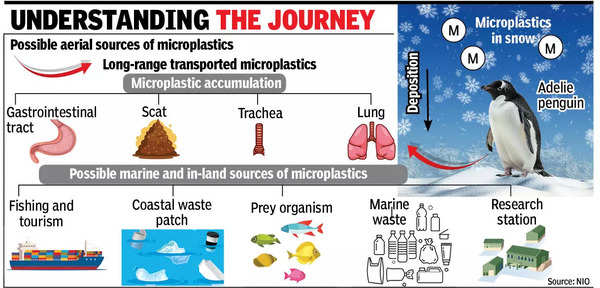Our Terms & Conditions | Our Privacy Policy
Scientists from NIO Goa find microplastics even in Antarctica’s Adelie penguins | Pune Media
PANAJI: Microplastics have infiltrated even the most remote regions of our planet, with alarming new evidence emerging from Antarctica. A recent study conducted by a team of researchers led by Mahua Saha, principal scientist, CSIR-National Institute of Oceanography (NIO Goa), on the Adelie penguin on Svenner Island, unveiled the presence of microplastics in its organs and gastrointestinal tissues.
Microplastics are tiny bits of plastic that are less than 5mm in size—about the size of a grain of rice or smaller. They come from many sources, like discarded plastic bags, bottles, and even from clothes. As a result, despite its isolation from significant human activity, the Antarctic region is not immune to the pervasive threat of microplastic pollution.
During the 39th Indian expedition to Antarctica, scientists of the CSIR-NIO, Goa, and the University of Calcutta, West Bengal, collected an adult Adelie penguin carcass, meticulously dissected it at the Bharti Research Station, Antarctica, and scientists at CSIR-NIO Goa examined its body samples to look for microplastics. They found that most of the plastic they discovered was in the form of fibres long, thin pieces that are often found in clothing and fishing gear. Interestingly, more than half of these fibres were blue, which might come from things like fishing nets or even clothes.
Sampling revealed microplastics in the gastrointestinal tracts of the penguins, with fibres constituting 97% of the identified particles. According to NIO, the ingestion of MPs by Adelie penguins can occur as they mistake these plastic particles for food. This poses risks of bioaccumulation within individual penguins and may also threaten entire populations, as scientists fear that adult penguins who commonly feed their young crop milk could inadvertently transfer harmful pollutants. This means that the pollutants can get passed down to the baby penguins, putting the entire population at risk.
The study revealed that many of the microplastics in the penguins’ bodies were not digested. This suggests that their bodies are struggling to break down these foreign particles, which could lead to toxic substances building up in their systems. These harmful particles could not only affect the penguins but also other animals that eat similar foods, like skuas (a type of bird that also lives in Antarctica).
The way microplastics are accumulated in penguins involves both direct ingestion and indirect ways. Adelie penguins primarily eat marine creatures like krill and fish, which have also been found to contain microplastics. This creates a worrying cycle of pollution that could impact the entire food web. To make matters worse, scientists have also found microplastics in the penguins’ respiratory tracts. Inhaling these tiny particles could lead to inflammation and breathing issues, adding yet another layer of danger for these majestic birds.
The findings serve as a clarion call for enhanced conservation efforts and stricter regulations on plastic production and disposal as microplastics invade even the most pristine environments on earth.
Images are for reference only.Images and contents gathered automatic from google or 3rd party sources.All rights on the images and contents are with their legal original owners.


Comments are closed.